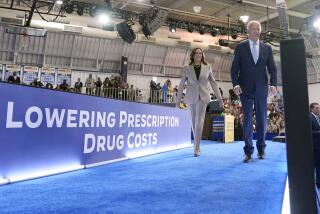Bush Official Touts Drug Plan
- Share via
A “national conversation” is needed so that seniors and disabled people make wise decisions during the upcoming enrollment for the Medicare prescription drug program, the Bush administration’s top health official said in Los Angeles this week.
Relatives, doctors, clergy, pharmacists and caregivers should be prepared to sit down with Medicare recipients and go through benefits that will be offered through private insurers beginning Nov. 15, said Michael Leavitt, secretary of the U.S. Department of Health and Human Services.
Enrollment is not mandatory, but Leavitt has cited estimates that between 28 million and 30 million of the 41 million eligible people will sign up for the program during the six-month enrollment that starts this fall.
Although some experts have criticized the program as too complex -- involving a variety of insurers, premiums, co-payments and covered drugs -- the Cabinet secretary told a gathering at White Memorial Medical Center that “it isn’t as complicated as people fear.”
His audience of about 30 people, representing healthcare and social service organizations, loudly applauded his call to educate senior and disabled clients about the new benefit, billed as the most significant addition to Medicare in its 40-year history.
Leavitt’s Los Angeles visit was part of a 100-city bus tour that began about two months ago and was expected to extend into fall. He and chief Medicare administrator Mark B. McClellan are meeting with local officials, asking them to get word of the benefits to those eligible.
Nationally, the average monthly premium is expected to be $32.20, about $5 less than had been anticipated. In addition, beneficiaries will have to pay an annual deductible of $250. After that, Medicare will pay 75% of prescription costs up to $2,000.
Beneficiaries will face a coverage gap, dubbed the doughnut hole, between $2,250 and $5,100 of annual expenses. Above that, Medicare will cover 95% of drug costs.
Industry officials say most senior citizens should be able to find plans that offer no deductible in exchange for some limits on their choices of drugs.
According to the nonpartisan Congressional Budget Office, the typical senior would save about $465 the first year.
But it’s unlikely that even the most cost-conscious insurers will be able to eliminate the doughnut hole. And some studies indicate that middle- and upper-income beneficiaries with chronic health conditions will face the highest out-of-pocket costs.
The cost of the drug benefit will be much lower for low-income beneficiaries, officials said. About one-third of Medicare beneficiaries -- roughly 14 million people -- will be eligible for government subsidies that could eliminate their premiums.
Leavitt advised against delaying enrollment in the plan until a health crisis looms. At that point, insurers would be likely to seek higher premiums from beneficiaries because they represent a higher risk, Leavitt told The Times.
This week, as Leavitt and McClellan publicized the program in several California cities, a congressman urged potential enrollees, especially retired workers with health benefits, to be wary.
“If the coverage [former employers] are providing is better than this benefit, you should stay where you are,” Rep. Pete Stark (D-Hayward) warned in a statement released by his office. “If you sign up for a new Medicare drug plan and quit your retiree drug coverage, you may lose all of your retiree health benefits and never be able to get them back.”
The initial enrollment ends May 15. Coverage will be available starting Jan. 1.
More to Read
Sign up for Essential California
The most important California stories and recommendations in your inbox every morning.
You may occasionally receive promotional content from the Los Angeles Times.










